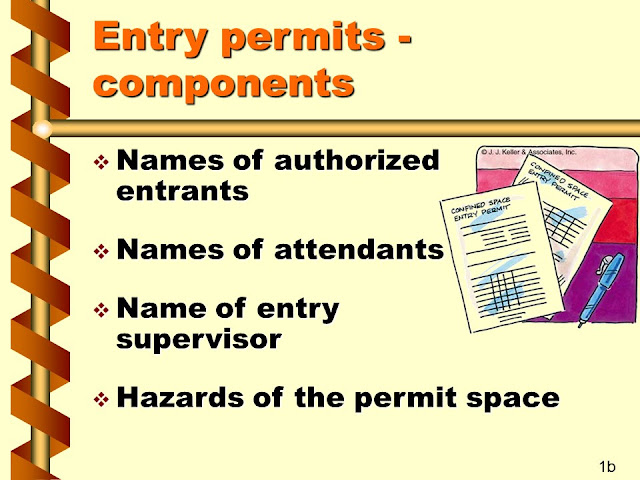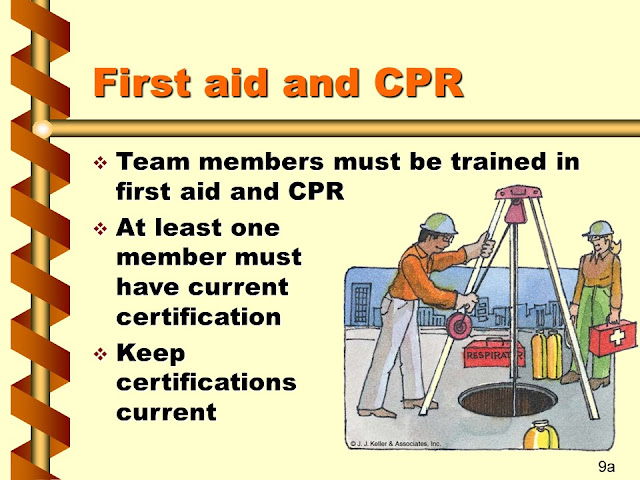Rescue/ Emergency Services (Confined Space)
END
Key Tags
Confined Space
(Permit-required)
Rescue/
Emergency
Services
Entry permits -
components
● Space to be entered
● Purpose of the entry
● Date and authorized
duration of the permit
1a
Entry permits -
components
● Names of authorized
entrants
● Names of attendants
● Name of entry
supervisor
● Hazards of the permit space
1b
Entry permits -
components
● Measures used to
isolate the permit
space
● Measures used to
eliminate or control
permit space hazards
before entry
● Acceptable entry conditions
1c
Entry permits -
components
● Results of initial and
periodic testing
performed
● Rescue and
emergency services
● Communication procedures
1d
Entry permits -
components
● Equipment required
● Other pertinent
safety information
● Any other work permits
1e
PPE and rescue
equipment
● Chemical protective clothing
● Eye and face
protection
● Respiratory
protection
2a
PPE for rescues
● Head protection
● Foot protection
● Hearing
protection
2b
Retrieval systems
● Retrieval equipment is
necessary for non-entry rescue
● Entrants must use
chest or full-body
harness
● Retrieval line
attachment
locations
3a
Retrieval systems
● Wristlets may be used instead
of the harness if using a harness
is infeasible
● Retrieval equipment
may not be required
if it increases the
risk of entry
3b
Entry permit system
● Know how to obtain a permit
● Entry supervisors are
responsible for endorsing the
permit and allowing entry to
begin
● Verify that all required
information has been filled in
4a
Entry permit system
● Permit must be available to
authorized entrants
● Verify that all necessary
equipment is in place
● Ensure that entry procedures
are understood
4b
Entry permit system
● Permits is not endorsed until
everything is ready
● Post the permit prior to entry
● Entry supervisor can cancel the
permit at any time
4c
Hazards of confined
spaces
● Engulfment
● Hazardous
atmospheres
• oxygen deficient
• oxygen enrichment
• toxic contaminants
• flammable contaminants
5a
Hazards of confined
spaces
● Safety and health
hazards
● Signs, symptoms, consequences
of
exposure
5b
Behavioral effects of
hazards
● Effects of oxygen
deficient
atmospheres
● Signs that a person
is breathing too
much oxygen
6a
Behavioral effects of
hazards
● Effects of other
hazard exposure
● Signs of fatigue
6b
Performing assigned
rescue duties
● Employees responsible for
rescue duties must be trained:
• as authorized entrants
• in specific
rescue duties
7a
Material Safety Data
Sheets
● Know where MSDSs are located
● Know how to
interpret the
information
8a
First aid and CPR
● Team members must be trained in
first aid and CPR
● At least one
member must
have current
certification
● Keep
certifications
current
9a
First aid and CPR
● Sources for training include:
• Red Cross
• American Heart
Association
• Insurance
providers
9b
Practicing rescues
● Rescue teams must practice to
ensure rescue plans are
adequate
● Rescuers have access to
confined spaces for practice
● Practice sessions must occur at
least every 12 months
10a
Practicing rescues
● Rescue operations must
simulate removing dummies or
actual persons from the space
● Representative spaces can be
used if they are typical of the
type of space where rescues
would occur
11a
Summary of key points
● Entry permits
● Rescue procedures
● Communications procedures
12a
Summary of key points
● Hazards
● PPE
● Retrieval equipment
12b
Summary of key points
● First aid and CPR
● MSDSs
● Practicing rescues





























Comments
Post a Comment